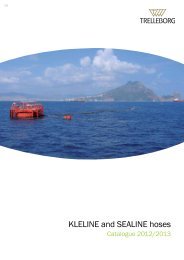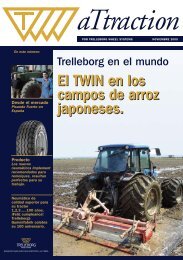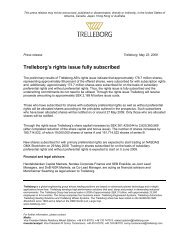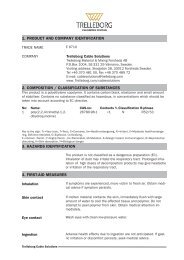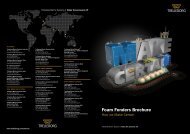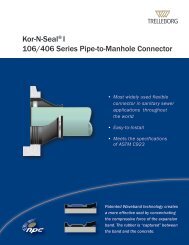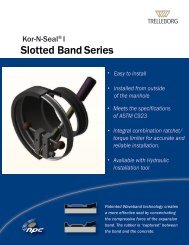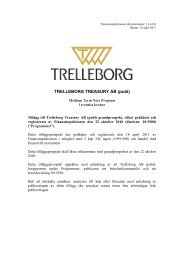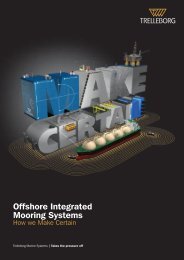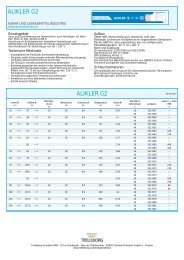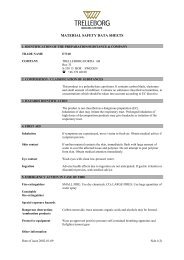Annual report 2011 - Trelleborg
Annual report 2011 - Trelleborg
Annual report 2011 - Trelleborg
You also want an ePaper? Increase the reach of your titles
YUMPU automatically turns print PDFs into web optimized ePapers that Google loves.
Note 1<br />
General information<br />
The Parent Company, <strong>Trelleborg</strong> AB (publ) is a limited liability company with its<br />
registered office in <strong>Trelleborg</strong>, Sweden. The Parent Company is listed on<br />
NASDAQ OMX Stockholm. The Board of Directors resolved to adopt these<br />
consolidated financial statements for publication on February 27, 2012.<br />
Summary of important accounting policies<br />
The most important accounting policies applied in the preparation of the consolidated<br />
financial statements are described below. These policies were applied<br />
consistently for all years presented, unless otherwise stated.<br />
Basis of preparation<br />
The <strong>Trelleborg</strong> Group’s financial statements have been prepared in accordance<br />
with the Swedish <strong>Annual</strong> Accounts Act, RFR 1 Supplementary Accounting Rules<br />
for Corporate Groups and the International Financial Reporting Standards (IFRS)<br />
and IFRIC interpretations, as approved by the EU. The Group’s financial statements<br />
have been prepared in accordance with the cost method, with the exception<br />
of certain financial instruments that were valued at fair value.<br />
In the Group’s multi-year summary, data up to and including 2003 was not<br />
prepared in accordance with IFRS, but is recognized in accordance with earlier<br />
Generally Accepted Accounting policies in Sweden.<br />
The Parent Company applies the same accounting policies as the Group,<br />
except in the instances stated below under “Parent Company’s accounting policies”.<br />
The differences arising between the Parent Company and the Group’s<br />
accounting policies are attributable to limitations on the ability to apply IFRS in<br />
the Parent Company, primarily as a result of the Swedish <strong>Annual</strong> Accounts Act.<br />
New and amended standards applied by the Group<br />
None of the IFRS or IFRIC interpretations that, for the first time, are mandatory<br />
for the fiscal year commencing on January 1, <strong>2011</strong> had any material impact on<br />
the Group.<br />
New standards, amendments and interpretations of existing<br />
standards that have not yet come into effect and have not<br />
been applied in advance by the Group<br />
–IAS 19 Employee Benefits was amended in June <strong>2011</strong>. The amendment<br />
requires the Group to cease application of the “corridor approach” and to<br />
instead recognize all actuarial gains and losses in other comprehensive income<br />
as they arise. Costs for services rendered in previous years will be recognized<br />
on an ongoing basis. Interest expenses and expected return on plan assets will<br />
be replaced by a net interest figure calculated using the discounting rate, based<br />
on the net surplus or deficit in the defined-benefit plan. The Group intends to<br />
apply the amended standard for the fiscal year commencing January 1, 2013<br />
and has not yet assessed the effects of this. The standard has not yet been<br />
adopted by the EU.<br />
–IFRS 9 Financial instruments addresses the classification, measurement<br />
and recognition of financial liabilities and assets. IFRS 9 was issued in<br />
November 2009 for financial assets and in October 2010 for financial liabilities<br />
and replaces those sections of IAS 39 related to classification and measurement<br />
of financial instruments. IFRS 9 states that financial assets have to be<br />
classified in two measurement categories: measurement at fair value or measurement<br />
at amortized cost. The classification is determined at initial recognition<br />
based on the company’s business model and the characteristic conditions in<br />
the contractual cash flows. For financial liabilities, no major changes will take<br />
place compared with IAS 39. The most significant change relates to liabilities<br />
identified at fair value. For these, the portion of the fair value change arising<br />
from own credit risk has to be recognized in other comprehensive income<br />
instead of profit and loss provided that this does not give rise to accounting<br />
mismatch. The Group intends to implement the new standard not later than the<br />
fiscal year commencing January 1, 2015 and has not yet assessed the effects.<br />
The standard has not yet been adopted by the EU.<br />
–IFRS 10 Consolidated financial statements is based on already existing<br />
principles defining control as the decisive factor in determining whether a<br />
company is to be included in the consolidated accounts. The standard provides<br />
further guidance that can be of assistance when it is difficult to determine<br />
control. The Group intends to apply IFRS 10 for the fiscal year commencing<br />
January 1, 2013 and has not yet assessed the full effects on the financial statements.<br />
The standard has not yet been adopted by the EU.<br />
–IFRS 11 Joint arrangements provides for a more realistic reflection of joint<br />
arrangements by focusing on the rights and obligations of the arrangement,<br />
rather than its legal form. There are two types of joint arrangements: joint operations<br />
and joint ventures. A joint operation arises when a joint operator has<br />
direct rights to the assets and obligations for the liabilities in a joint arrangement.<br />
In such an arrangement, the recognition of assets, liabilities, revenue and<br />
expenses is based on the owner’s share of these. A joint venture arises when<br />
the joint operator has rights to the net assets in a joint arrangement. In such an<br />
arrangement, the owner is required to recognize its share in accordance with the<br />
equity method. The proportional method is no longer permissible. The Group<br />
intends to apply IFRS 10 for the fiscal year commencing January 1, 2013 and<br />
NOTES – GROUP<br />
has not yet assessed the full effects on the financial statements. The standard<br />
has not yet been adopted by the EU.<br />
–IFRS 12 Disclosures of interests in other entities includes the disclosure<br />
requirements for subsidiaries, joint arrangements, associated companies and<br />
unconsolidated structured entities. The Group intends to apply IFRS 12 for the<br />
fiscal year commencing January 1, 2013 and has not yet assessed the full<br />
effects on the financial statements. The standard has not yet been adopted by<br />
the EU.<br />
–IFRS 13 Fair value measurement aims to improve consistency and reduce<br />
complexity in the application of fair value measurement by providing a precise<br />
definition and a shared source in IFRS for fair value measurements and the<br />
associated disclosures. The requirements do not expand the area of application<br />
for when it is required to use fair value, but provide guidance on how it should<br />
be applied when other IFRSs already require or permit fair value measurement.<br />
The Group has not yet assessed the full effects of IFRS 13 on the financial<br />
statements. The Group intends to apply the new standard for the fiscal year<br />
commencing January 1, 2013. The standard has not yet been adopted by<br />
the EU.<br />
No other IFRS or IFRIC interpretations that have not yet come into effect are<br />
expected to have any material impact on the Group.<br />
Consolidated accounts<br />
Group<br />
The consolidated accounts include the Parent Company and all subsidiaries and<br />
associated companies.<br />
Subsidiaries<br />
Subsidiaries are all companies (including special purpose entities, SPEs) in<br />
which the Group has the right to formulate financial and operating strategies in<br />
a manner commonly accompanying participations amounting to more than half<br />
of the voting rights. The occurrence and effect of potential voting rights that are<br />
currently available to utilize or convert are taken into account in the assessment<br />
of whether the Group exercises controlling influence over another company. The<br />
Group also determines that control exists despite not having a participation<br />
exceeding half of the voting rights but for which it nonetheless is able to govern<br />
financial and operating strategies in the company.<br />
Subsidiaries are included in the consolidated financial statements from the<br />
date on which control is transferred to the Group. They are excluded from the<br />
consolidated financial statements from the date on which the control ceases.<br />
The purchase method is used to recognize the Group’s business combinations.<br />
The consideration for the acquisition of a subsidiary comprises the fair<br />
value of transferred assets, liabilities that the Group assumes from previous<br />
owners of the acquired company and the shares issued by the Group. The<br />
consideration also includes the fair value of all assets or liabilities that result<br />
from an agreement covering a contingent consideration. Identifiable acquired<br />
assets and assumed liabilities in a business combination are initially measured<br />
at fair value on the date of acquisition. For each acquisition, that is, on an<br />
acquisition-by-acquisition basis, the Group determines whether non-controlling<br />
interest in the acquired company is to be recognized at fair value or at the<br />
shareholding’s proportional share in the carrying amount of the acquired company’s<br />
identifiable net assets.<br />
Acquisition-related costs are expensed as they arise.<br />
If the business combination is completed in several steps, the previous<br />
equity interests in the acquired company are measured at fair value at the date<br />
of acquisition. Any gain or loss arising is recognized in profit or loss.<br />
Each contingent consideration to be transferred by the Group is recognized<br />
at fair value at the date of acquisition. Subsequent changes to the fair value of<br />
a contingent consideration classed as an asset or liability are recognized in line<br />
with IAS 39, either in profit and loss or in other comprehensive income. Contingent<br />
considerations classed as equity are not remeasured and the subsequent<br />
settlement is recognized in equity.<br />
Goodwill is initially measured as the amount by which the total purchase<br />
consideration and fair value of non-controlling interests exceeds the value of<br />
identifiable acquired assets and assumed liabilities. If the purchase consideration<br />
is lower than the fair value of the acquired company’s net assets, the difference<br />
is recognized directly in profit and loss.<br />
Intra-Group transactions, balance-sheet items and income and costs for<br />
intra-Group transactions are eliminated. Gains and losses resulting from intra-<br />
Group transactions and which are recognized in assets are also eliminated.<br />
Where necessary, the accounting policies for subsidiaries have been adjusted to<br />
guarantee consistent application of the Group’s policies.<br />
Associated companies<br />
Associated companies are companies in which the Parent Company directly or<br />
indirectly has a significant, but not controlling, influence, generally corresponding<br />
to between 20 and 50 percent of the voting rights. Investments in associated<br />
companies are recognized in accordance with the equity method and are initially<br />
recognized at cost. The Group’s recognized value of the holdings in associated<br />
companies includes the goodwill identified in conjunction with the acquisition,<br />
<strong>Annual</strong> Report <strong>2011</strong> <strong>Trelleborg</strong> AB 75




